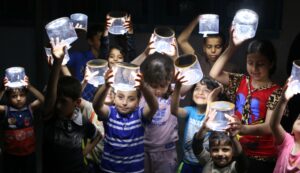October 2023: Hamas and Israel War
On Saturday morning, October 7, 2023, Hamas commenced brutal attacks against Israel, firing thousands of rockets into Southern Israel and militants crossing into Israel on the ground and by air. These horrific attacks included the murder and kidnapping of civilians, including children. Israel began bombing Gaza and moving against the Hamas fighters entering Southern Israel. As of Thursday, October 12, the death toll stands at almost 3,000 people, with thousands more injured and more than 300,000 internally displaced Palestinians inside Gaza, according to the United Nations. The 16-year ongoing blockade of Gaza closed the territory off by land and sea. This past week, the Israeli government extended the siege and exercised collective punishment by cutting off electricity, food, water, and fuel in Gaza, where more than 2.2 million people live, over half of whom are under the age of 18. With hundreds of thousands of Israeli reservists massing at the border with Gaza, fears are now of a full-scale ground invasion.
August 2022: Churches for Middle East Peace (CMEP) calls on U.S. Government to address underlying causes of Israeli violence against Gaza
CMEP calls on the US government to work to preserve the ceasefire and to insist Israel ends its 15- year blockade of Gaza, an ongoing humanitarian catastrophe, and an act of collective punishment that has turned Gaza into the world’s largest open-air prison. The U.S. must stop enabling Israeli impunity in violating human rights and humanitarian law, and instead, work toward a comprehensive and enduring end to the conflict that will result in human rights and equality for all Israelis and Palestinians. Read More
February-March 2022: Gaza 101 Mini Course with American Friends of Combatants for Peace
Gaza Amendment Coalition letter to U.S. Senators supporting a proposal requiring a report on the humanitarian impact of severe restrictions on movement, access, and goods in and out of Gaza [8/15/2021]
A large coalition of groups including CMEP wrote to members of the U.S. Senate urging them to support an amendment, sponsored by Sen. Bernie Sanders, to the 2022 National Defense Authorization Act (NDAA) that would require a report on the humanitarian impact of severe restrictions on movement, access, and goods in and out of Gaza. Read More
April 2021: Peacemakers Working in Gaza
Watch CMEP’s April 2021 webinar featuring local organizations working in Gaza. Beth Oppenheim, the Director of International Relations at Gisha – Legal Center for Freedom of Movement, and Bassam Nasser, the Head of Office in Gaza for Catholic Relief Services, speak about their work and experiences as humanitarian workers and human rights advocates dedicated to serving the people of Gaza. Facilitating this discussion is Craig Swandby, a Senior Policy and Legislative Specialist at Catholic Relief Services. Watch
Additional Resources
Lights for Gaza Campaign [2017]
During Spring 2017 CMEP partnered with Rebuilding Alliance to send solar powered Luci Lights into Gaza. Individuals like you raised enough funds to send 570 Luci Lights to people in Gaza. Thank you to everyone who participated!! Learn more here.
Background: Infrastructure Crisis in Gaza [2017]
During the 2014 Gaza War, the main power plant in Gaza was damaged severely. Since then, the infrastructure crisis has grown exponentially. Exacerbated by the difficulty in purchasing Diesel due to a financial conflict between the Palestinian Authority and Hamas, Gazans are impacted in three crucial areas, energy, water and communications, which stunts any hope for stability. Currently, Gazans typically only have electricity for 3-4 hours per day, leaving them in darkness for about 21 hours. Continue Reading
Gaza: Working Toward a Better Future [07/24/2017]
Gaza Field Manager for Catholic Relief Services (CRS), Bassam Nasser, speaks with CMEP’s Director of Advocacy and Government Relations, Kyle Cristofalo, about CRS’ work in Gaza providing emergency relief to the most vulnerable. Nasser also discusses his hope for a better future and steps to take to help move toward a just resolution of the Israeli-Palestinian conflict. Watch
Growing Up In Gaza [07/18/2017]
Fulbright Scholar Oday Abdaljawwad speaks with CMEP Executive Director Rev. Dr. Mae Elise Cannon about growing up in Gaza and the unique challenges the ongoing humanitarian crisis places on children. Abdaljawwad is currently a Development and Advocacy Intern with CMEP. Watch
Gaza: Searching for Light [03/28/2017]
In 2014 Gaza’s main power plant sustained severe damage as a result of the Gaza War. Three years later the power plant remains mostly inactive. Today, most Gazans live in the dark for as many as 21 hours every day. Learn about the current realities of life in Gaza and where there might be opportunities for hope. Watch
Hand on the Switch and Lights for Gaza [03/09/2017]
Hear Tania Hary, Executive Director of the Israeli human rights organization Gisha, and Executive Director of Churches for Middle East Peace Rev. Dr. Mae Elise Cannon, recently returned from Gaza, engage in a conversation on the humanitarian crisis in Gaza. Learn about the current realities of Palestinian life in Gaza where most Gazans live in the dark for as many as 21 hours every day. Watch



